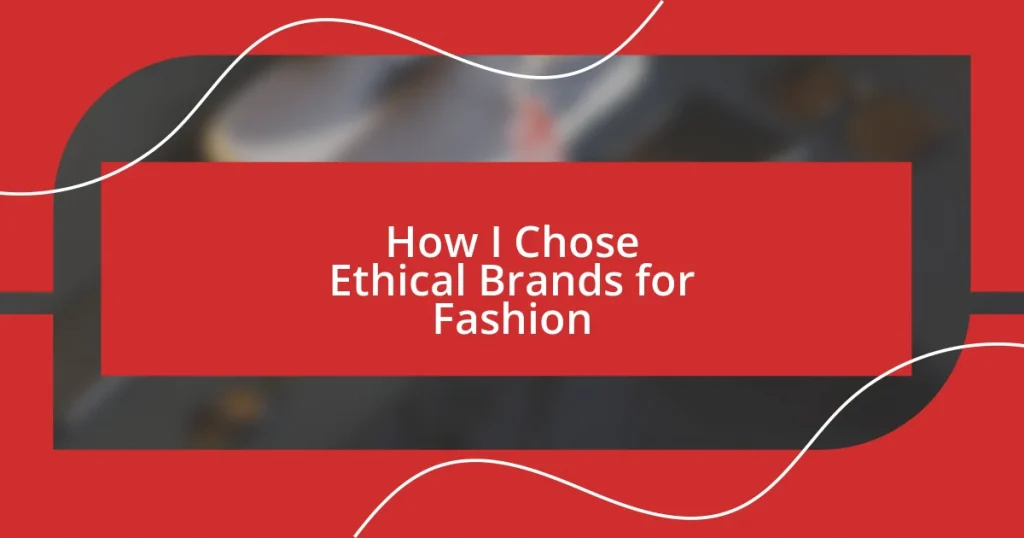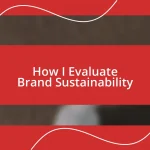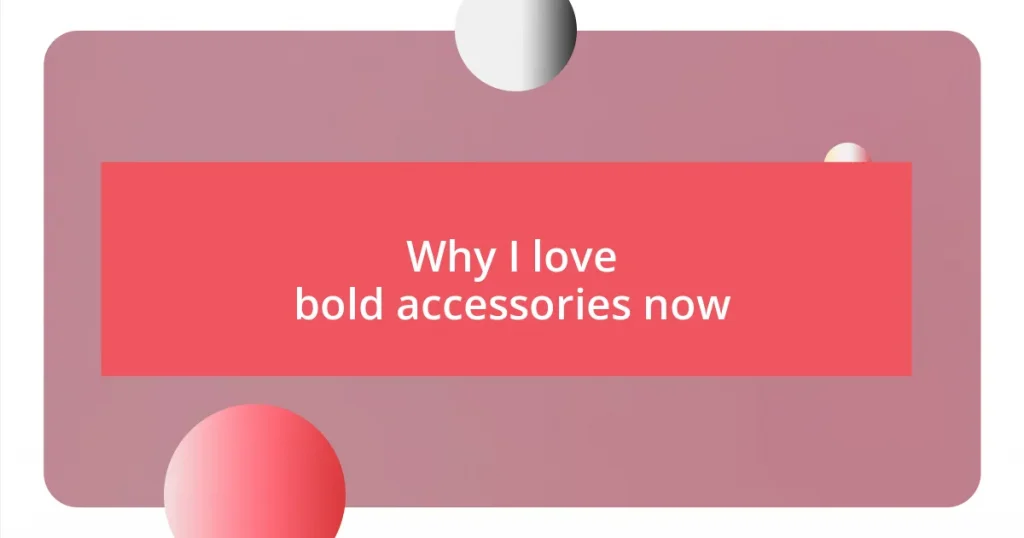Key takeaways:
- Ethical fashion brands emphasize sustainability, transparency, and fair labor practices, allowing consumers to connect emotionally with the stories behind their clothing.
- Researching brand transparency is crucial; key areas to evaluate include supply chain information, labor practices, environmental impact, certifications, and customer reviews.
- Customer feedback plays a significant role in assessing a brand’s ethical commitment, revealing insights about product quality and overall brand integrity.

Understanding Ethical Fashion Brands
Ethical fashion brands prioritize sustainability, fair labor practices, and environmentally friendly materials. When I first learned about this, I couldn’t help but feel a sense of relief. It was a big shift from the overwhelming fast fashion industry, where the impact of my choices felt hidden and complicated.
What really struck me was the transparency these brands offer. For instance, I remember discovering a small company that detailed their entire supply chain online. It made me reflect: how often do we pause to consider the stories behind the clothes we wear? Knowing that my purchase supports artisans or workers receiving fair wages deeply resonated with me on a personal level.
Another layer of ethical fashion is the use of eco-friendly materials. I recall purchasing clothes made from organic cotton and recycled fabrics, feeling an emotional connection to the earth with each wear. It’s fascinating to think how our clothing can tell stories about the environment and the people behind them, weaving together a narrative that goes beyond mere aesthetics.

Identifying Key Values in Ethics
Identifying key values in ethics can often feel like sifting through a vast ocean of information. I’ve learned to focus on a few essential values that resonate deeply with me. For example, I prioritize brands that demonstrate transparency. A little while ago, I stumbled upon a clothing label that not only shared their sourcing practices but also offered stories of the communities they support. Reading those stories made the clothes feel more meaningful to me, as it shaped a deeper connection to my wardrobe.
Another crucial value is the commitment to sustainability. The journey I took toward understanding sustainable materials was eye-opening. During a visit to a local boutique, I discovered linen garments crafted from sustainably sourced flax. Each piece caught my attention, and I could almost hear the whispers of nature in the fabric. It made me realize how clothing can impact the world positively, creating a ripple effect that goes beyond fashion trends.
Fair labor practices are perhaps the most significant aspect. When I encountered a brand that openly addressed fair wages and safe working conditions for their workers, I felt empowered. I remember having a conversation with the brand’s founder at a pop-up event, where she shared her passion for ethical practices. That encounter left me feeling inspired and determined to choose brands that stand by their workers. It’s not just about making purchases; it’s about making a statement.
| Value | Description |
|---|---|
| Transparency | Brands that openly share their sourcing and supply chain practices. |
| Sustainability | Commitment to using eco-friendly materials and practices. |
| Fair Labor Practices | Ensuring fair wages and safe working conditions for workers. |
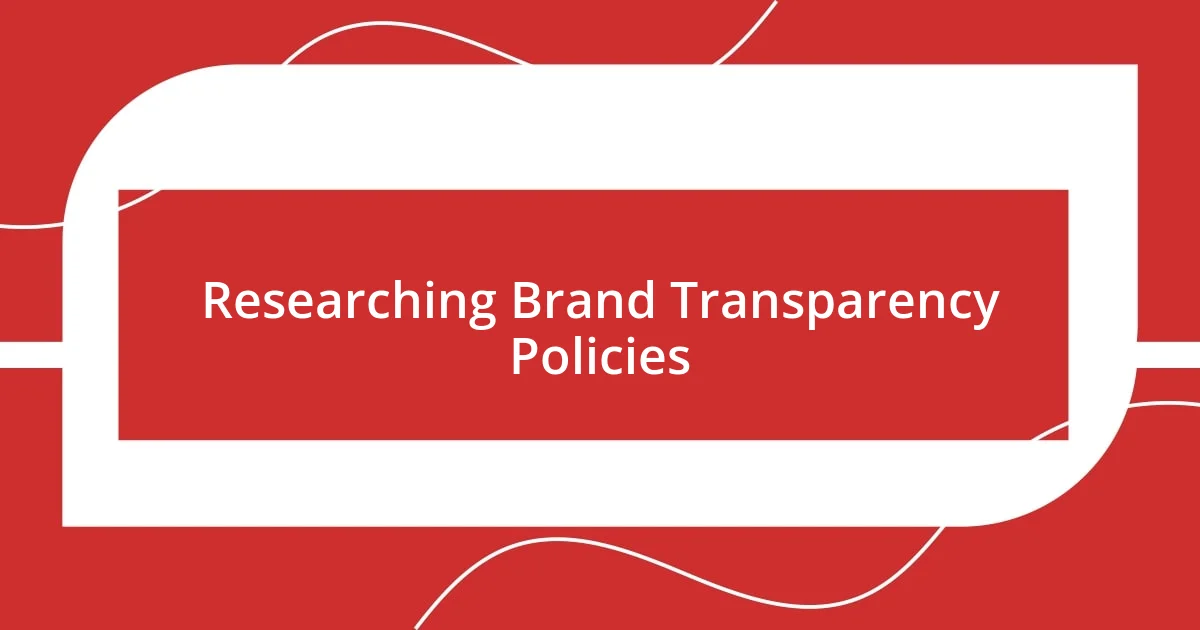
Researching Brand Transparency Policies
Researching brand transparency policies feels more like uncovering layers of a story than merely checking off a box. I remember spending hours digging into different brands’ websites, seeking information on their supply chains and labor practices. One brand’s commitment to sharing detailed reports on their factories truly stood out to me; it felt like a window into their ethical commitments. It reminded me that the brands I support should be willing to show their cards, and knowing what goes on behind the scenes creates a safer space for informed choices.
When I evaluate a brand’s transparency, I often look for specific signs that demonstrate their integrity. Here are a few key areas I focus on during my research:
- Supply Chain Information: Does the brand detail where and how their products are made?
- Labor Practices: Are there clear policies regarding fair wages and working conditions?
- Environmental Impact: Do they disclose practices around waste reduction and material sourcing?
- Certifications: Are there third-party certifications that validate their ethical claims?
- Consumer Reviews: What are other customers saying about their experiences with the brand’s ethics?
Each of these elements adds depth to my understanding, making it clear if a brand lives up to its claims. I’ve found that this level of transparency not only establishes trust but also deepens my connection to the brand, making me more excited and proud to wear their pieces.

Assessing Sustainable Material Usage
Assessing sustainable material usage in fashion requires a keen eye for detail and an understanding of what truly makes a fabric eco-friendly. I remember feeling a rush of excitement when I first came across organic cotton; it was like unveiling a hidden treasure. Not only is it grown without harmful pesticides, but it also promotes healthier soil. Discovering brands that highlight such materials made me feel like I was contributing to a more sustainable future, one piece of clothing at a time.
When choosing brands, I’ve learned to ask myself, “What’s behind the fabric?” This question has driven me to explore options like Tencel and recycled polyester. I vividly recall walking through a local thrift store and spotting a jacket made from recycled materials. The thought that this garment could have had a previous life, perhaps as a plastic bottle, captivated me. It’s amazing how utilizing waste can be transformed into something beautiful and functional in our wardrobe.
Lastly, certifications play a pivotal role in my assessment process. When I see labels like GOTS (Global Organic Textile Standard) or OEKO-TEX, I feel reassured that the material has undergone stringent testing for sustainability. It reminds me of the time I contacted a brand to understand their certification process and the sincerity in their response was palpable. Knowing that the brand shares my values creates a profound sense of trust and connection, transforming a mere purchase into a conscious decision. Isn’t it empowering to wear something that aligns with our beliefs?
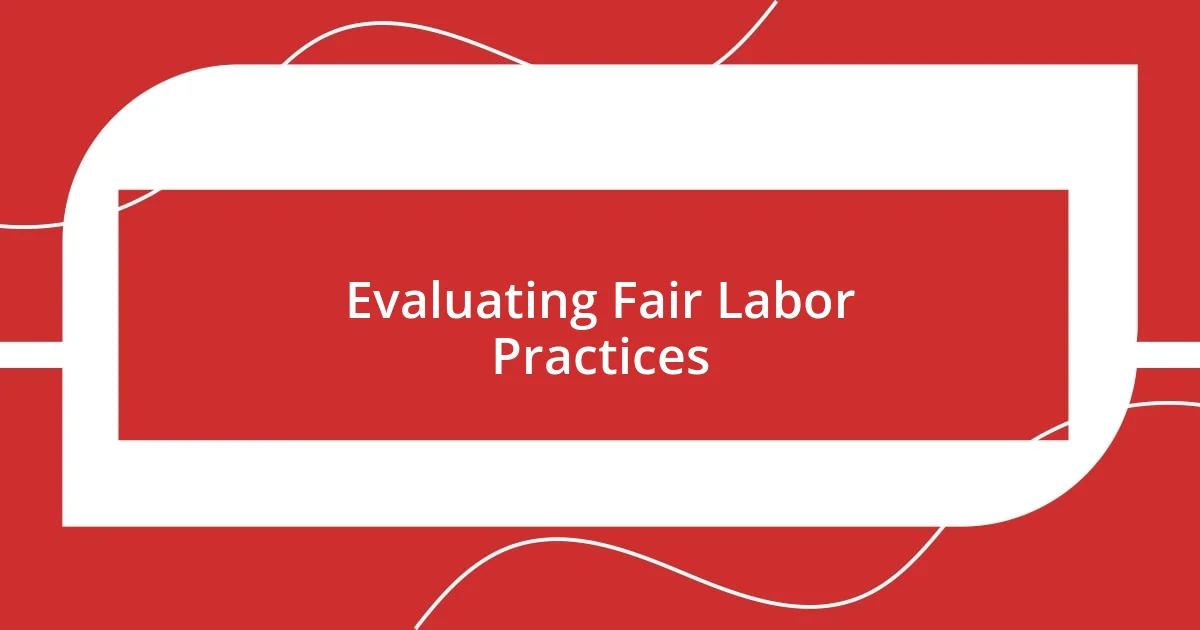
Evaluating Fair Labor Practices
Evaluating fair labor practices can feel like navigating a complex maze, but it’s critical for ensuring that the hands that make our clothes are treated with dignity. I’ve personally experienced a range of emotions when delving into this topic. One instance that stands out was when I discovered a brand proudly showcasing their policy on fair wages. It ignited a sense of hope in me—knowing that my money supports workers who deserve better living conditions and compensation.
I also pay close attention to brands that showcase their labor practices transparently. For example, I once stumbled upon a company that not only posted its labor-related audits online but also shared stories of the artisans behind their products. This approach humanized the process for me and made it easy to connect my shopping choices to real people. How often do we pause to think about who made our clothes? A little research can uncover brand commitments that resonate deeply, reminding us that every garment carries a story worth respecting.
Sometimes, I go deeper by seeking third-party evaluations of a brand’s labor practices, such as Fair Trade certifications. When I received a notification that a clothing line I loved got recognized for its ethical practices, I felt a rush of affirmation. It was a powerful reminder that ethical fashion isn’t just an ideal; it’s a real, achievable goal. These validations provide confidence in my choices, and I can’t help but feel proud knowing that I’m supporting a brand that aligns with my commitment to social justice in fashion.

Reading Customer Reviews and Feedback
Reading customer reviews and feedback has become an essential part of my journey in selecting ethical fashion brands. One afternoon, while sipping my favorite herbal tea, I started scrolling through reviews for a new sustainable label I was considering. I was struck by how honest and heartfelt some of the comments were—customers shared their experiences as if they were friends giving advice. It made me wonder, how often do we rely on the opinions of strangers to guide our choices?
What I’ve noticed is that reviews often reveal much more than just a product’s quality; they can provide insights into a brand’s commitment to ethics. I recall a time when multiple reviews highlighted poor customer service from a so-called “ethical” brand. This raised a red flag for me. If they treat their customers poorly, how might they treat their workers? Can a brand truly be ethical if the experience they deliver is subpar?
Sometimes, I like to dig into the stories behind the reviews. A particular glowing review about a jacket’s durability caught my eye, but what really touched me was the reviewer’s note about its life cycle—how they had worn it on hikes, picnics, and even cozy nights in. It reminded me that my purchase would have its own journey—a life beyond the store. Engaging with customer feedback in this way deepens my connection to the brand, making me feel part of a community that values transparency, authenticity, and shared experiences in ethical fashion.

Making Informed Purchasing Decisions

Researching Brand Transparency
Researching brand transparency is a vital step in my purchasing process, and it often leads me down intriguing rabbit holes. There was a time when I found myself completely engrossed in a brand’s website, scouring their sustainability claims and reading through their supply chain information. It felt like being a detective—unpacking every claim and ensuring they backed it up with solid evidence. I tend to ask myself, “Do they share their manufacturing processes transparently?” If the answer is unclear, I usually walk away. Isn’t it worth our time to seek out brands that stand proud behind their practices?
I’ve had moments when a simple FAQ section on a brand’s site has changed my perception entirely. I remember a specific case where a company shared not only where their materials come from but also logistical challenges they face in maintaining ethical standards. This openness resonated with me deeply; it reminded me that ethical fashion can be complex and is often a continual work in progress. When I see brands transparently confronting their challenges, I feel more compelled to support them, understanding that they’re making genuine efforts.
What also strikes me is how social media sheds light on brand ethics—especially when customers share their experiences. Just the other day, I came across an Instagram post from an influencer who had visited a local workshop of a brand I love. She shared behind-the-scenes footage of the artisans at work, earning fair wages and expressing pride in their craftsmanship. That kind of firsthand storytelling not only affirmed my choice but sparked a genuine connection that goes beyond the clothes. After all, aren’t our buying decisions richer when they’re intertwined with the stories of the people behind them?










